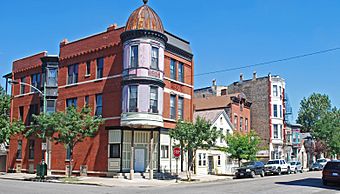Pilsen Historic District facts for kids
Quick facts for kids |
|
|
Pilsen Historic District
|
|

Pilsen Historic District, 21st and Wood, Chicago IL
|
|
| Location | Chicago, Illinois, United States |
|---|---|
| NRHP reference No. | 10240018 |
| Added to NRHP | February 1, 2006 |
The Pilsen Historic District is a special area in the Pilsen neighborhood of Chicago. It's known as a historic district because it has many old buildings. Pilsen is part of the Lower West Side in Chicago. It's one of the few places in the city that still has buildings that survived the Great Chicago Fire of 1871.
Pilsen was officially started in 1878. This made it an important part of Chicago's growth and changes. Over time, many different groups of people have called Pilsen home.
Contents
A Home for Immigrants
Pilsen has a rich history of welcoming people from all over the world.
Early European Settlers
In the late 1800s, many Czech immigrants moved to Pilsen. They named the area after Pilsen, a big city in their home country, Czechia. Other groups from the Austro-Hungarian Empire also settled here. These included Slovaks, Slovenes, Croats, and Austrians. People from Poland and Lithuania also came to live in Pilsen. By 1934, many Polish, Croatian, Lithuanian, and Italian families lived there. This made Pilsen a neighborhood where many working-class families from different backgrounds lived together.
The Rise of the Mexican Community
In the mid-1900s, more and more Mexican immigrants began to arrive in Pilsen. This was especially true after 1962. Many Mexican workers came to the United States for jobs. Also, a neighborhood west of Halsted Street was torn down to build the University of Illinois at Chicago. This made many Mexican families move to Pilsen.
Even though this area was once home to many Italian Americans, it became a key place for Mexican immigrants. By 1970, people of Latino heritage became the majority in Pilsen. The neighborhood continued to be a place where immigrants, mostly from Mexico, first settled in Chicago.
Challenges Faced by Newcomers
Early Mexican residents in Pilsen faced difficulties. Some businesses in the 1950s and 1960s showed signs that were unwelcoming. Banks sometimes refused to give home loans to people in Pilsen. This was because it had a large Mexican immigrant population. Despite these challenges, the community grew strong.
By 2003, Pilsen was mostly Mexican-American. The Chicagoland Chamber of Commerce even called Pilsen "an authentically Mexican neighborhood." This shows how important Mexican culture became to the area.
Pilsen Becomes a Historic District
On February 1, 2006, Pilsen was officially named a National Historic Register District. This means its history and buildings are protected and recognized as important to the country.
Pilsen's Migrant Shelter
Pilsen is also home to Chicago's largest shelter for migrants. It opened in late 2023. This shelter provides a place for new arrivals to stay.
Gentrification in Pilsen
Gentrification is when a neighborhood changes. New, wealthier people move in, and property values go up. This can sometimes make it hard for long-time residents to afford to stay.
Early Signs of Change
As early as 1985, people saw that Pilsen might experience gentrification. It was close to downtown Chicago and had lower property values. This made it attractive for new developments.
Pilsen residents and community groups have worked hard to protect their neighborhood. They protested against big plans like the Chicago 21 Plan in the 1970s and the Chicago 1992 World's Fair in the 1980s. The community has stayed strong by working together with local homeowners and the city.
Ongoing Community Efforts
Groups like The Pilsen Alliance, started in 1998, continue to fight for the community. They have protested against the expansion of the University of Illinois at Chicago into Pilsen.
In recent years, gentrification has led to some changes in Pilsen. Some residents have had to move, and some businesses have closed. This has changed the culture of the historically Mexican neighborhood. As of 2023, community groups in Pilsen are still protesting rising property taxes. These higher taxes make it harder for residents to keep their homes.




